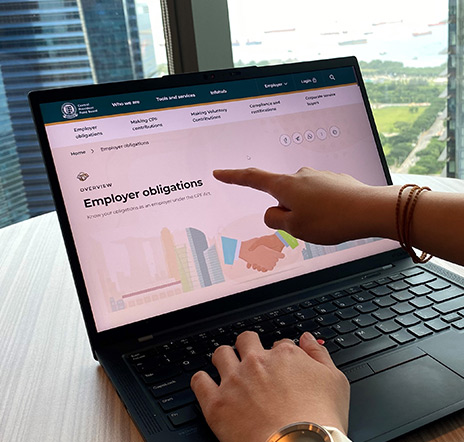-
Accounting Advisory
Our accounting advisory team help businesses meet their complex financial reporting requirements. The team can support in applying new financial reporting standards, IFRS/ US GAAP conversions, financial statement preparation, consolidation and more.
-
Payroll
Our team can handle your payroll processing needs to help you reduce cost and saves time so that you can focus on your core competencies
-
Managed accounting and bookkeeping
Outsourcing the financial reporting function is a growing trend among middle market and startup companies, as it provides a cost-effective way to improve the finance and accounting function. Our team can help with financial statement preparation, consolidation and technical on-call advisory.
-
Accounting Advisory
Our team helps companies keep up with changes to international and domestic financial reporting standards so that they have the right accounting policies and operating models to prevent unexpected surprises.
-
Crypto Accounting Advisory Service
Our team can help you explore appropriate accounting treatment for accounting for holdings in cryptocurrencies, issuance of cryptocurrencies and other crypto/blockchain related accounting issues.
-
ESG Reporting and Accounting
As part of our ESG and Sustainability Services, our team will work with you on various aspects of ESG accounting and ESG reporting so that your business can be pursue a sustainable future.
-
Expected Credit Loss
Our team of ECL modelling specialists combine help clients implement provisioning methodology and processes which are right for them.
-
Finance Transformation
Our Finance Transformation services are designed to challenge the status quo and enable your finance team to play a more strategic role in the organisation.
-
Managed Accounting and Bookkeeping Services
Outsourcing the financial reporting function is a growing trend among middle market and startup companies, as it provides a cost-effective way to improve the finance and accounting function. Our team can help with financial statement preparation, consolidation and technical on-call advisory.
-
CFO as a Service
Fast, flexible CFO support to guide growth, empower your team, and ensure lasting impact.
-
Business Tax Advisory
Our business tax team can help you navigate the international tax landscape, grow through mergers and acquisitions, or plan an exit strategy.
-
Corporate Finance
Our corporate finance team helps companies with capital raising, mergers and acquisitions, private equity, strategic joint ventures, special situations and more.
-
Financial Due Diligence
From exploring the strategic options available to businesses and shareholders through to advising and project managing the chosen solution, our team provide a truly integrated offering
-
Valuations
Our valuation specialists blend technical expertise with a pragmatic outlook to deliver support in financial reporting, transactions, restructuring, and disputes.

-
Sustainability with the ARC framework
Backed by the CTC Grant, businesses can tap on the ARC Framework to gain access to sustainability internally, transform business processes, redefine job roles for workers, and enhance productivity. Companies can leverage this grant to drive workforce and enterprise transformation.

-
Business Tax Advisory
Our business tax team can help you navigate the international tax landscape, grow through mergers and acquisitions, or plan an exit strategy.
-
Corporate Tax Compliance
Our corporate tax teams prepare corporate tax files and ruling requests, support you with deferrals, accounting procedures and realise tax benefits.
-
Tax Governance
Our Tax Governance Services are designed to assist organisations in establishing effective tax governance practices, enabling them to navigate the intricate tax environment with confidence.
-
Goods and Services Tax
Our GST team supports organisations throughout the entire business life-cycle. We can help with GST registration, compliance, risk management, scheme renewals, transaction advisory and more.
-
Transfer Pricing
Our Transfer Pricing team advises clients on their transfer pricing matters on and end-to-end basis right from the designing of policies, to assistance with annual compliance and assistance with defense against the claims of competing tax authorities.
-
Employer Solutions
Our Employer Solutions team helps businesses remain compliant in Singapore as well as globally as a result of their employees' movements. From running local payroll, to implementing a global equity reward scheme or even advising on the structure of employees’ cross-border travel.
-
Private Client Services
Our private client services team provides a comprehensive cross section of advisory services to high net worth individuals and corporate executives, allowing such individuals to concentrate on their business interests.
-
Welfare and benefits
We believe that a thriving team is one where each individual feels valued, fulfilled, and empowered to achieve their best. Our welfare and benefits aim to care for your wellbeing both professionally and personally.
-
Career development
We want to help our people learn and grow in the right direction. We seek to provide each individual with the right opportunities and support to enable them to achieve their best.

In this article, we discuss the top five considerations when managing payroll in Singapore:
- Complying with the Employment Act
- Accounting for CPF and other statutory contributions
- Ensuring accuracy and timeliness in tax filing
- Staying updated on regulatory changes
- Leveraging payroll technology or professional services
Managing payroll in Singapore involves more than just paying employees on time. With frequent legislative updates and a tightly regulated environment, businesses must stay informed and compliant to avoid costly penalties and operational disruptions.
Whether you are a small business owner or an HR professional, understanding the complexities of Singapore’s payroll system is essential. Here are the top five considerations when managing payroll in Singapore:
1. Complying with the Employment Act
Singapore’s Employment Act outlines basic employment terms and working conditions, including regulations on salary payments, overtime, leave entitlements, and termination procedures. Payroll teams must ensure that all salary components adhere to these statutory requirements.
Key points to remember:
- Calculate wages in accordance with prescribed guidelines
- Paying salaries promptly, within 7 days after the end of each salary period
- Issue itemised payslips to employees
- Maintain proper payroll records for at least two years
- Ensure clear communication of employment terms and salary components to employees
Whilst the above may not seem difficult to comply with, we have encountered several employers who still rely on Excel to process payroll. Unfortunately, this often results in undetected errors that only come to light when an issue arises.
2. Managing CPF and other statutory contributions
The Central Provident Fund (CPF) is one of the critical components of Singapore payroll. Employers must correctly classify wages and make CPF contributions for all eligible employees. The contribution rates vary depending on an employee’s age, immigration status and monthly salary. We have seen a number of companies being caught out by the recent changes by either forgetting to increase the Ordinary Wage ceiling or by miscalculating the new Additional Wage ceiling.
It is also worth noting that the CPF rules differ from the tax rules and therefore you may have pay items that can be excluded from Singapore tax but would have to be included for CPF purposes. We come across clients that are aware that a particular benefit (e.g. red packets during Chinese New Year) are exempt from tax if they do not exceed SGD200 and therefore exclude it from payroll, even though it is still subject to CPF.
In addition to CPF, employers must also manage other statutory contributions, including:
- Skills Development Levy (SDL) – to support workforce training
- Foreign Worker Levy (FWL) – applicable to certain work pass holders
- Self-Help Group (SHG) contributions – such as CDAC, SINDA, MBMF, and ECF, depending on the employee’s ethnicity, immigration status and income
3. Ensuring accuracy and timeliness in tax filing
Employers are responsible for submitting employee remuneration details, this includes benefits provided, to the Inland Revenue Authority of Singapore (IRAS). This is especially important under the Auto-Inclusion Scheme (AIS), which is mandatory for companies with five or more employees on payroll over the course of the year.
Key requirements include:
- Staying updated on IRAS guidelines
- Using IRAS approved payroll software
- Preparing Form IR8A, Appendix 8A/8B, or Form IR8S, where applicable
- Submitting year-end tax information electronically by 1 March each year
- Managing Form IR21 tax clearance for foreign employees ending their employment, and for Singapore Permanent Residents (SPRs), where applicable
We come across clients who are unaware of the tax clearance requirements and this is especially important because failure to file on time can mean that the employer becomes liable for the employee’s outstanding tax liability.
4. Staying updated on regulatory changes
Singapore frequently updates its labour laws, tax regulations, and contribution rates. These changes can significantly impact payroll calculations. Employers must proactively monitor these updates to maintain compliance.
Ways to stay informed:
- Subscribe to updates from government agencies (e.g. MOM, IRAS, CPF Board)
- Conduct regular payroll audits
- Use compliant payroll software
- Consult with payroll or legal experts
- Provide training for HR and payroll staff on new regulations
5. Leveraging payroll technology or professional services
Given the complexity of Singapore’s payroll environment, many companies choose to use cloud-based payroll software or outsource payroll to professional providers.
Benefits include:
- Real-time statutory updates
- Audit-ready reporting
- Improved data security and confidentiality
- Employee self-service portals
- Integration with accounting and HR systems
Outsourcing payroll can also free up internal resources and provide access to expert advice on compliance and best practices.
What's next?
Looking to simplify your payroll operations? By focusing on these five areas, you’ll be well-equipped to streamline your payroll processes and avoid costly mistakes. Managing your payroll in Singapore is about ensuring compliance, maintaining accuracy, and adapting to regulatory changes. The team at Grant Thornton is here to help. Reach out to us for a personalised consultation tailored to your business needs.









